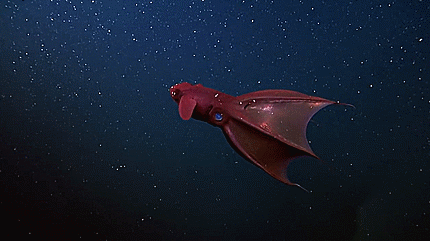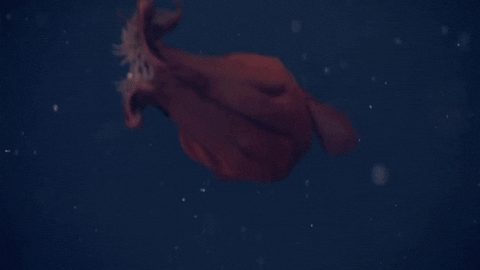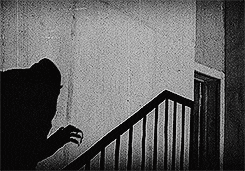Is the Vampire Squid Real?
Yes, it’s real! But don’t worry, it’s not really a vampire ... or a squid

Believe it or not, the vampire squid is, indeed, a real creature! In fact, it’s a small and adorably-weird cephalopod that lives in the deep sea and despite its common name, it’s not actually a true squid (or a vampire—just in case you were still wondering). Rather, it is the sole member of its own order—Vampyromorphida—and its Latin name, Vampyroteuthis infernalis, literally translates to “vampire squid from hell.” While it may sound pretty scary, humans have nothing to fear from the vampire squid.
Never Miss An Update
Sign up for Ocean Conservancy text messages today.
Similar to “actual” vampires, vampire squid love the darkness of the deep, cold ocean and are able to survive with very little oxygen (as little as 3% oxygen saturation!). But you’d be wrong to suppose they drink blood. Instead, they use their beaks (no fangs here) to eat something referred to as “marine snow,” which is comprised of dead plankton, dead and decaying animal carcasses, fecal matter and other teeny tiny particles of organic matter, which is still pretty gross if you ask me.
Their bodies are fairly small, growing to about one foot as a mature adult, and are typically dark red, reddish-brown or black. Like many of our other cephalopod friends, vampire squid have eight arms. Unique to vampire squid, however, is the dark red web-like material that connects these arms, much like a gothic cape on our deep-sea Dracula. Inside this webbing are pouches where they hide two retractile sensory filaments (similar to that of a squid’s tentacles) that, once extended, reach well past the other eight arms—helping them eat their “snow”. They have two small, earlike fins on either side as their only method of propulsion, keeping them rather slow-moving, and two large, blood red eyes—supposedly the main inspiration behind the vampire squid name. In certain lights, their eyes actually look blue. Fun fact: regardless of color, they supposedly have the largest eye-to-body ratio of any other critter in the animal kingdom.

Unlike actual squid, vampire squid won’t spray ink to avoid predators—it wouldn’t do much good to protect them in the darkness of the mesopelagic zone (approximately 660 – 3,300 feet below the ocean surface where less than 1% of light reaches). Instead, they turn their bodies essentially inside out to expose spooky, spiny projections to scare away predators. And if they’re really irritated, they’ll expel a bioluminescent mucus cloud that will glow for up to ten minutes, distracting predators as they make a slow, floaty (sparkly) getaway. This takes a lot out of them energetically, so they must be fairly agitated for this to occur.
Needless to slay, our vampire squid friends are quite misunderstood but there’s no need to let bad information drive you batty. Give fangs for this ink-redible ocean life and take action now to protect their deep ocean home from seabed mining.
